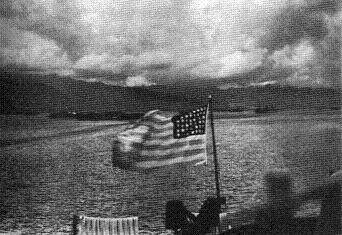![]() The Pacific War Online Encyclopedia
The Pacific War Online Encyclopedia
|
| Previous: Millikin, John | Table of Contents | Next: Minakami Genzo |

U.S. Army. Via
Morison (1950)
Milne Bay (150.363E
10.322S) is a large inlet at the southeastern tip of New Guinea. It was discovered by
John Moresby in 1873. The bay itself is unusually deep (over 300
fathoms or 550 meters in places) and makes a superb natural anchorage. However, the
approaches were reef-strewn and
treacherous. In late 1941 it was
extremely primitive, with almost no
facilities other than a
jetty for
loading copra.
There were
good locations for airstrips
nearby, and in early June 1942 a company of American engineers covered by a company of Australian militia arrived and began developing
airfields. These were joined by Australian 7 Brigade
in early July. Malaria and
difficulties with logistics were
overcome as Dutch coastal
steamers became adept at negotiating the poorly charted and reef-strewn
approaches in the China Strait. (MacArthur had been
allocated 29 of these 2000 to 4000-ton vessels following the
fall of Java.) By 22 August, 7 Brigade
had been joined by 18
Brigade (of 7
Australian Division; 8500 men under Major General Cyril Clowes)
and there were 34 Australian P-40
Kittyhawks operating out of the new airfield, which was heavily protected by antiaircraft guns.
The Japanese attempted to seize the area in August 1942. The result was the first land defeat of the Japanese in the Pacific, at the hands of the Australians.
In August 1942 the Japanese high command decided to
supplement the overland march from Kokoda
against Port Moresby with an amphibious assault around
the tail of New Guinea. This required the capture of Milne Bay to clear
the route and to serve as a staging point for the landing barges.
Japanese forces from 17
Army began landing
on the north
shore of Milne Bay on the night of 25 August 1942. The Japanese were
overconfident, due to mistaken intelligence that the garrison was just
a single battalion, and landed
without adequate air or fire support. The
convoy consisted of light
cruisers Tenryu and Tatsuta,
destroyers Tanikaze,
Urakaze,
and Hamakaze, and subchasers Ch-22
and Ch-24 escorting transports Kinai Maru and Nankai Maru. The landing force was
1200 men of 5 Kure SNLF reinforced with elements of 5 Sasebo SNLF and 350 airfield engineers. The convoy was spotted by a coastwatcher that tipped off
Clowes to the imminent invasion.
Due to dense fog, the landings took place considerably further east than the Japanese planned. This gave the Australian garrison time to prepare their defense, and it meant that the P-40s were unhindered in their operations. The Kittyhawks escorted a strike of B-17s that damaged the Nankai Maru (8416 tons, 16.0 knots) and forced the convoy to retreat before it had fully unloaded. It is thought that only about 1100 of the Japanese troops got ashore. An attempt to reinforce with seven large barges failed when Allied aircraft destroyed the barges and stranded the Japanese troops on Goodenough Island. A second Japanese convoy brought in another 775 men from 3 Kure SNLF on 29 August who immediately went into battle.
The Australians attempted to hold at KB Mission, but the Japanese attacked with light tanks and flamethrowers,
and English-speaking Japanese shouting "Withdraw!" sufficiently
confused the Australian militia that they soon were forced to withdraw
across the Gama River. An attempt at an ambush by an Australian company was badly timed and driven off. However, the Japanese light tanks repeatedly bogged down in the jungle,
finally giving out for good some 2.5 miles (4 km) west of KB Mission. This was fortunate for the defenders, whose antitank sticky bombs had become moldy and useless.
Clowes formed his main
defense line
on Number 3 airstrip, the easternmost airstrip, which was still under
construction. The defenses were stiffened with a number of American halftracks. On the night of 30 August, the Japanese attempted three times to take the airfield by frontal assault, but each time they ran
into a wall of heavy machine gun and mortar
fire. Dawn found the ground east of the airstrip covered with with Japanese corpses. The main Japanese force had withdrawn back into the jungle, leaving a rearguard of snipers and machine gun nests.
By 31 August 1942 the Australians were able to go over to the attack, and Hyakutake was forced to order the evacuation of the Japanese troops. The evacuation took place on the nights of 4 and 5 September 1942, successfully embarking about 1300 of the 2000 Japanese troops that had been engaged.
On 22 October 1942 MacArthur landed 800 Australian troops on Goodenough Island, who trapped the 353 stranded Japanese troops. The surviving Japanese were evacuated by submarine on the night of 26 October.
Following the Allied victory, Milne Bay became a major
base, troop staging area, and amphibious training center.
References
The Pacific War Online Encyclopedia © 2007-2008, 2010-2011 by Kent G. Budge. Index